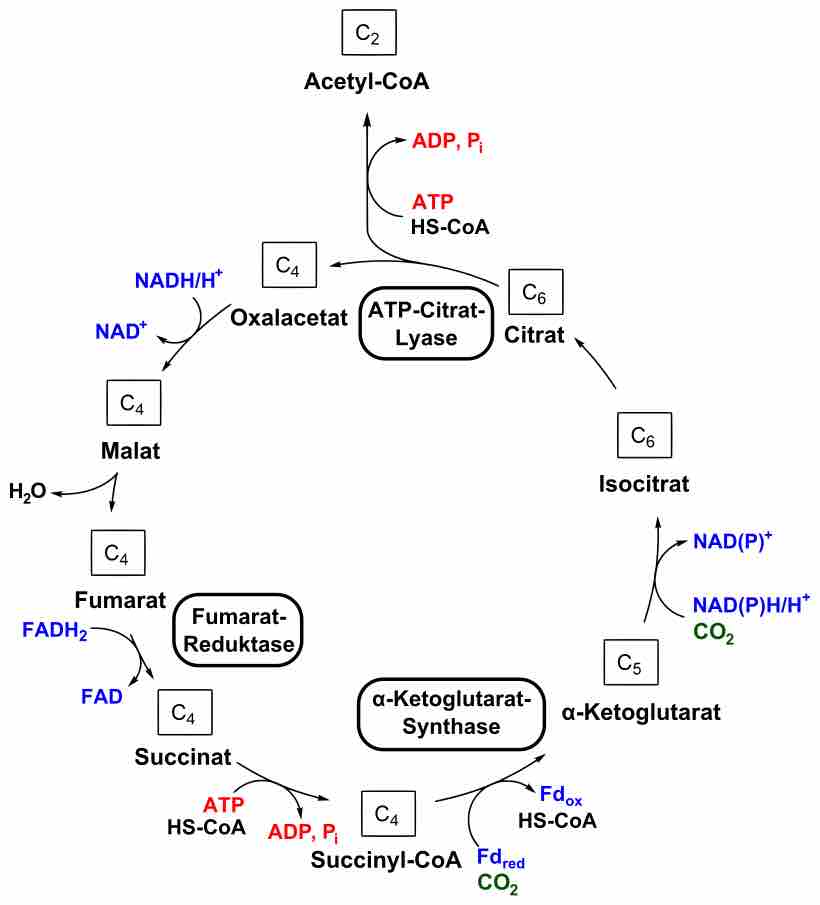The citric acid cycle (TCA) or Krebs cycle, is a process utilized by numerous organisms to generate energy via the oxidation of acetate derived from carbohydrates, fats, and proteins into carbon dioxide . The cycle plays a critical role in the maintenance of numerous central metabolic processes. However, there are numerous organisms that undergo reverse TCA or reverse Krebs cycles. This process is characterized by the production of carbon compounds from carbon dioxide and water. The chemical reactions that occur are the reverse of what is seen in the TCA cycle . There are numerous anaerobic organisms that utilize a cyclic reverse TCA cycle and an example includes organisms classified as Thermoproteus. The following is a brief overview of the reverse TCA cycle.

The Reverse Citric Acid Cycle
An overview of the reverse citric acid cycle.
Reverse TCA Summary
The reverse TCA cycle is a series of chemical reactions by which organisms produce carbon compounds from carbon dioxide and water. The reverse TCA cycle requires electron donors and often times, bacteria will use hydrogen, sulfide or thiosulfate for this purpose. The reverse TCA is considered to be an alternative to photosynthesis which produces organic molecules as well. Reverse TCA, a form of carbon fixation, utilizes numerous ATP molecules, hydrogen and carbon dioxide to generate an acetyl CoA. This process requires a number of reduction reactions using various carbon compounds. The enzymes, unique to reverse TCA, that function in catalyzing these reactions include: ATP citrate lyase, 2-oxoglutarate:ferredoxin oxidoreductase, and pyruvate:ferredoxin oxidoreductase. ATP citrate lyase is one of the key enzymes that function in reverse TCA. ATP citrate lyase is the enzyme responsible for cleaving citrate into oxaloacetate and acetyl CoA. These enzymes are unique to reverse TCA and are necessary for the reductive carboxylation to occur.
In reverse TCA, the following occurs in a cyclic manner:
1) oxaloacetate is converted to malate (NADH/H+ is utilized and NAD+ is produced)
2) malate is converted to fumarate (H20 molecule is produced)
3) fumarate is converted to succinate via a fumarate-reductase enzyme (FADH2 is converted to FAD)
4) succinate is converted to succinyl-CoA (ATP is hydrolyzed to ADP+Pi)
5) succincyl CoA is converted to alpha-ketoglutarate via an alpha-ketoglutarate synthase (reduction of carbon dioxide occurs and oxidation of coenzyme A)
6) alpha-ketoglutarate is converted to isocitrate (NAD(P)H/H+ and CO2 is broken down to NAD(P+)
7) isocitrate is converted to citrate
8) ATP citrate lyase is then used to convert citrate to oxaloacetate and acetyl CoA (ATP is hydrolyzed to ADP and Pi).
9) Pathway is cyclic and continues cycle from step 1
An example of a microorganism that utilizes reverse TCA includes Thermoproteus. Thermoproteusis type of prokaryotic that is characterized as a hydrogen-sulfur autotroph. The organisms classified as Thermoproteus utilizes sulfur reduction for metabolic processes. As previously mentioned, organisms that use reverse TCA may use sulfur as an electron donor to carry out this metabolic process.